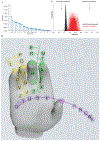A brain-computer typing interface using finger movements
- PMID: 37465143
- PMCID: PMC10353344
- DOI: 10.1109/ner52421.2023.10123912
A brain-computer typing interface using finger movements
Abstract
Intracortical brain computer interfaces (iBCIs) decode neural activity from the cortex and enable motor and communication prostheses, such as cursor control, handwriting and speech, for people with paralysis. This paper introduces a new iBCI communication prosthesis using a 3D keyboard interface for typing using continuous, closed loop movement of multiple fingers. A participant-specific BCI keyboard prototype was developed for a BrainGate2 clinical trial participant (T5) using neural recordings from the hand-knob area of the left premotor cortex. We assessed the relative decoding accuracy of flexion/extension movements of individual single fingers (5 degrees of freedom (DOF)) vs. three groups of fingers (thumb, index-middle, and ring-small fingers, 3 DOF). Neural decoding using 3 independent DOF was more accurate (95%) than that using 5 DOF (76%). A virtual keyboard was then developed where each finger group moved along a flexion-extension arc to acquire targets that corresponded to English letters and symbols. The locations of these letter/symbols were optimized using natural language statistics, resulting in an approximately a 2× reduction in distance traveled by fingers on average compared to a random keyboard layout. This keyboard was tested using a simple real-time closed loop decoder enabling T5 to type with 31 symbols at 90% accuracy and approximately 2.3 sec/symbol (excluding a 2 second hold time) on average.
Keywords: Communication; Fingers; Intracortical Brain Computer Interface; Motor Cortex; Motor Decoding; Typing.
Figures



Similar articles
-
A flexible intracortical brain-computer interface for typing using finger movements.bioRxiv [Preprint]. 2024 Apr 26:2024.04.22.590630. doi: 10.1101/2024.04.22.590630. bioRxiv. 2024. PMID: 38712189 Free PMC article. Preprint.
-
Classification of Individual Finger Movements Using Intracortical Recordings in Human Motor Cortex.Neurosurgery. 2020 Sep 15;87(4):630-638. doi: 10.1093/neuros/nyaa026. Neurosurgery. 2020. PMID: 32140722
-
Speech-related dorsal motor cortex activity does not interfere with iBCI cursor control.J Neural Eng. 2020 Feb 5;17(1):016049. doi: 10.1088/1741-2552/ab5b72. J Neural Eng. 2020. PMID: 32023225 Free PMC article. Clinical Trial.
-
The state-of-the-art of invasive brain-computer interfaces in humans: a systematic review and individual patient meta-analysis.J Neural Eng. 2025 Mar 12;22(2). doi: 10.1088/1741-2552/adb88e. J Neural Eng. 2025. PMID: 39978072
-
Sensors and decoding for intracortical brain computer interfaces.Annu Rev Biomed Eng. 2013;15:383-405. doi: 10.1146/annurev-bioeng-071910-124640. Annu Rev Biomed Eng. 2013. PMID: 23862678 Free PMC article. Review.
Cited by
-
Evolution, biomechanics, and neurobiology converge to explain selective finger motor control.Physiol Rev. 2024 Jul 1;104(3):983-1020. doi: 10.1152/physrev.00030.2023. Epub 2024 Feb 22. Physiol Rev. 2024. PMID: 38385888 Free PMC article. Review.
-
Brain-Computer Interfaces with Intracortical Implants for Motor and Communication Functions Compensation: Review of Recent Developments.Sovrem Tekhnologii Med. 2024;16(1):78-89. doi: 10.17691/stm2024.16.1.08. Epub 2024 Feb 28. Sovrem Tekhnologii Med. 2024. PMID: 39421626 Free PMC article. Review.
-
Effects of Packet Loss on Neural Decoding Effectiveness in Wireless Transmission.Brain Sci. 2025 Feb 20;15(3):221. doi: 10.3390/brainsci15030221. Brain Sci. 2025. PMID: 40149743 Free PMC article.
-
NIDCD's 5-year strategic plan seeks innovations in assistive device technologies.J Neural Eng. 2024 Jan 10;21(1):10.1088/1741-2552/ad171b. doi: 10.1088/1741-2552/ad171b. J Neural Eng. 2024. PMID: 38113536 Free PMC article. No abstract available.
References
-
- Ostrach Teresia R.. Typing Speed: How Fast is Average: 4,000 typing scores statistically analyzed and interpreted.
Grants and funding
LinkOut - more resources
Full Text Sources
